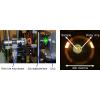当前位置:
X-MOL 学术
›
Phys. Rev. Materials
›
论文详情
Our official English website, www.x-mol.net, welcomes your feedback! (Note: you will need to create a separate account there.)
Understanding cracking behavior of glass from its response to hydrostatic compression
Physical Review Materials ( IF 3.4 ) Pub Date : 2020-06-25 , DOI: 10.1103/physrevmaterials.4.063607 Siva Priya Jaccani , Randall E. Youngman , John C. Mauro , Liping Huang
Physical Review Materials ( IF 3.4 ) Pub Date : 2020-06-25 , DOI: 10.1103/physrevmaterials.4.063607 Siva Priya Jaccani , Randall E. Youngman , John C. Mauro , Liping Huang

|
Under sharp contact loading, glass deforms elastically and then plastically in the form of densification, shear flow, and network structure changes, which interplay with each other and lead to stress/residual stress buildup and cracking. Vickers indentation is often used to study the deformation and cracking behavior of glass; however, it is not easy to delineate the individual contribution of each deformation mode under indentation due to experimental difficulties associated with in situ investigations at a local scale (tens of microns) under nonuniform stresses. Given the stress field under an indenter is largely compressive, hydrostatic compression and decompression in a diamond anvil cell (DAC) were used in this work to help understand the response of glass to indentation during the loading and unloading process. To this end, an optical microscopy technique was developed to measure the volume of glass under pressure in the DAC by using argon as a pressure transmitting medium. This provided the densification and recovery of glass under hydrostatic compression and decompression. In situ Brillouin light scattering experiments were carried out at the same time to measure the elastic response of glass to pressure. A few multicomponent glasses with vastly different indentation cracking behaviors were selected for study in this work. Our experiments reveal that glass with a high ability to undergo reversible structure changes in response to hydrostatic compression and decompression shows a high cracking resistance under sharp contact loading.
中文翻译:

从玻璃对静水压的响应中了解玻璃的开裂行为
在剧烈的接触载荷下,玻璃会发生弹性变形,然后以致密化,剪切流和网络结构变化的形式发生塑性变形,这些相互作用相互影响,并导致应力/残余应力累积和破裂。维氏压痕通常用于研究玻璃的变形和开裂行为。然而,由于与原位相关的实验困难,很难描述压痕下每个变形模式的个体贡献。在非均匀应力下以局部尺度(数十微米)进行研究。考虑到压头下的应力场大部分是压缩的,因此在这项工作中使用了金刚石砧盒(DAC)中的静液压压缩和减压,以帮助理解玻璃在加载和卸载过程中对压痕的响应。为此,开发了光学显微镜技术以通过使用氩气作为压力传递介质来测量DAC中压力下的玻璃体积。这提供了在静水压缩和减压下玻璃的致密化和恢复。原位同时进行布里渊光散射实验以测量玻璃对压力的弹性响应。在这项工作中,选择了一些具有不同压痕开裂行为的多组分玻璃进行研究。我们的实验表明,具有高能力承受静水压缩和减压的可逆结构变化的玻璃在尖锐的接触载荷下显示出较高的抗裂性。
更新日期:2020-06-25
中文翻译:

从玻璃对静水压的响应中了解玻璃的开裂行为
在剧烈的接触载荷下,玻璃会发生弹性变形,然后以致密化,剪切流和网络结构变化的形式发生塑性变形,这些相互作用相互影响,并导致应力/残余应力累积和破裂。维氏压痕通常用于研究玻璃的变形和开裂行为。然而,由于与原位相关的实验困难,很难描述压痕下每个变形模式的个体贡献。在非均匀应力下以局部尺度(数十微米)进行研究。考虑到压头下的应力场大部分是压缩的,因此在这项工作中使用了金刚石砧盒(DAC)中的静液压压缩和减压,以帮助理解玻璃在加载和卸载过程中对压痕的响应。为此,开发了光学显微镜技术以通过使用氩气作为压力传递介质来测量DAC中压力下的玻璃体积。这提供了在静水压缩和减压下玻璃的致密化和恢复。原位同时进行布里渊光散射实验以测量玻璃对压力的弹性响应。在这项工作中,选择了一些具有不同压痕开裂行为的多组分玻璃进行研究。我们的实验表明,具有高能力承受静水压缩和减压的可逆结构变化的玻璃在尖锐的接触载荷下显示出较高的抗裂性。



























 京公网安备 11010802027423号
京公网安备 11010802027423号